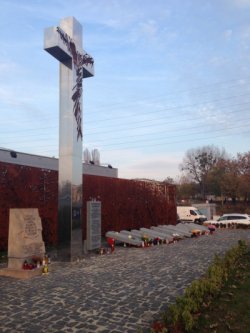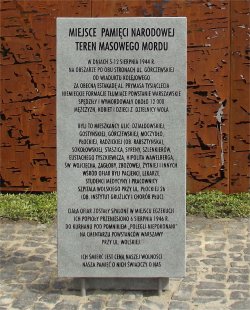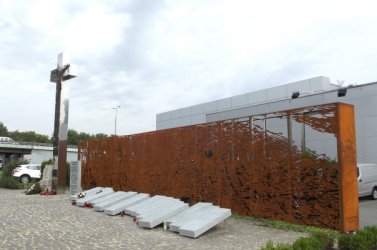 |
32 Gorczewska street. The initial plaque read as follows, "The place sacrificed with the blood of the ones who perished for the Homeland's freedom. Here from the 5th to 12th August 1944 in massive executions of civilians the Nazis shot 12 thousand Polish people including the patients and the personnel of the Płocka hospital."
The place was then undergoing various changes.
On November 2, 2009 an additional plaque made of black marble was presented, the one that contained the detailed information of the events dated from the 5th to 12th August 1944. A tall wooden crucifix was set next to the plaques.
Later on the wooden crucifix was replaced with the metal one, with an interesting figure of suffering Christ.
In July 2014 an essential change was made as far as the visual composition of the memorial place is concerned.
Again the plaque with the detailed description of the events was replaced. Instead of the former not legible black plaque (mind the reflections from the side of a shiny area) a beige plaque was installed, on which one can read:
"THE PLACE OF NATIONAL REMEMBRANCE
THE AREA OF MASSIVE MURDER
At the time from the 5th to 12th August 1944 on the area of both sides of the Górczewska street from the railway overpass towards the up-to-date trestle bridge of the Prymas Tysiąclecia Avenue, soldiers of the German forces intended for the suppression of the Warsaw Uprising compelled and murdered ca. 12 thousand of men, women and children - the Wola district dwellers.
The victims were the residents of the following streets: Działdowska, Gostyńska, Górczewska, Moczydło, Płocka, Radzicka (currently known as Rabsztyńska), Sokołowska, Staszica, Syreny, Szlenkierów, Eustachego Tyszkiewicza, Hipolita Wawelberga, Św. Wojciecha, Zagłoby, Zbożowa, Żytnia and others.
The victims included the patients, doctors, medicine students and employees of the Wolski Hospital situated In the Płocka 26 street (currently the Institute of Tuberculosis and Lung Diseases).
The victims' bodies were burnt in the place of the execution.
The ashes were relocated on August 6, 1946 to the burial mound situated under the monument Fallen - Undefeated at the Warsaw Insurgents cemetery in the Wolska street.
THEIR DEATH IS THE COST OF OUR FREEDOM.
OUR REMEMBRANCE OF THEM TELLS OF US."
By the plaque a dozen of stone plaques with the names and the dates of birth of 1085 known victims of the massive murder were set horizontally, in the alphabetical order according to the streets of their residence.
The openwork wall made of steel sheet metal that separates both the plaques and the crucifix from the car showroom and the department store at the back is believed to be an important architectural element of the area.
In the place of the current monument, the car park and the department store there used to be a backyard on which thousands of civilians were being murdered in August 1944. The author of the monument is a sculptor Marek Moderau.
The monument was built thanks to the financial support of the Council for the Protection of Struggle and Martyrdom Sites.
|






